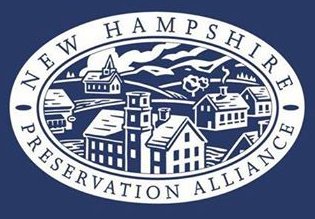2019 Preservation Achievement Award Winner: Brady Sullivan Properties Lofts 34 in Nashua
The historic building known as the “Card Shop” was part of a sprawling industrial complex in Nashua owned by the The Nashua Gummed and Coated Paper Company, whose construction began in 1889. Brady Sullivan purchased the vacant and neglected building in 2015, and since then has transformed the 300,000 sq.ft. building into a trendy home for 200 apartments. (Photo courtesy of Brady Sullivan.)
Brady Sullivan Properties for the revitalization of 34 Franklin Street, Nashua, as Lofts 34
With partners: City of Nashua; NH Division of Historical Resources; Lisa Mausolf, LM Preservation; Hayner/Swanson, Inc.; Universal Window and Door; Energy Electric Co., Inc.; Dimond Protection Services, LLC; and Emond Plumbing & Heating Mechanical Contractors.
The Nashua Gummed and Coated Paper Company started construction of its industrial complex in 1889, and over the years added some ten additions to meet changing production needs. Unlike Nashua’s dominant textile industries, the “Card Shop,” as it was known, was able to thrive during the early 20th century in large part due to research and new product development. Renamed Nashua Corporation in 1952, the company continued to operate here until the 1990s. Generations of Nashua families found work in this Franklin Street facility.
Dimond Protection Services, LLC; Emond Plumbing & Heating Mechanical ContractorsThe Nashua Gummed and Coated Paper Company started construction of its industrial complex in 1889, and over the years added some ten additions to meet changing production needs. Unlike Nashua’s dominant textile industries, the “Card Shop,” as it was known, was able to thrive during the early 20th century in large part due to research and new product development. Renamed Nashua Corporation in 1952, the company continued to operate here until the 1990s. Generations of Nashua families found work in this Franklin Street facility, now Lofts 34.
By the time Brady Sullivan purchased the building in 2015, the building had been vacant for at least seven years and the absentee owners had long since stopped paying taxes—a reversal from when Nashua Corp was the city’s largest taxpayer in the 1960s. The massive 300,000 square-foot brick building had been vandalized, covered in graffiti and was a haven for the homeless. Work on the building began in February 2016, removing asbestos and stemming the flow of the water pouring into the structure.
The mill’s 500-plus deteriorated windows in a dozen configurations were character-defining elements that reflected the various accretions and additions the building had seen, but represented a major challenge. Presenting another challenge were the 180 locations where once large window openings had been in-filled with brick and small incongruous aluminum slider windows.
Inside, the architects thoughtfully superimposed 200 apartments on an interior plan that also was highly irregular, reflecting the constant addition of new sections over the years. Brick walls and fire doors separated what were originally distinct areas with different functions. The storehouses on the south side of the building had additional stories with lower ceiling heights and the levels did not correspond to those in the main mill areas. In this area, two-level living units were the solution. Several units even incorporate a former elevator shaft.
In short, this was not cookie cutter mill rehabilitation, but rather a complicated design challenge that resulted in a range of apartment sizes and configurations that boast quirky and unique elements from the building’s former life.
This federal historic tax credit project has been warmly received by City of Nashua officials and builds on the City’s goal of bringing new people to downtown. Its 200 market-rate units make it one of the biggest projects in downtown Nashua in recent years, and like earlier mill rehabilitations at Clocktower Place and Cotton Mill, the former Card Shop infuses the former industrial area with new energy that is essential to the health of the downtown.







